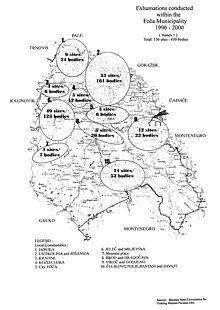Foča massacres
| Foča massacres | |
|---|---|

Chart showing exhumations carried out between 1996 and 2000 in the Foča municipality, Bosnia and Herzegovina. (Photograph provided courtesy of the ICTY)
|
|
| Location | Foča, Bosnia and Herzegovina |
| Date | 7 April 1992 to January 1994 (Central European Time) |
| Target | Bosniaks |
|
Attack type
|
Mass killing |
| Perpetrators | Serb forces |
The Foča massacres, were a series of killings committed by Serb military, police, and paramilitary forces on Bosniak civilians in the Foča region of Bosnia and Herzegovina (including the towns of Gacko and Kalinovik) from 7 April 1992 to January 1994. In a 1997 judgement against Novislav Đajić, the Bavarian Appeals Chamber ruled that the killings in which he was involved in June 1992 were acts of genocide.
In numerous verdicts, the International Criminal Tribunal for the former Yugoslavia (ICTY) ruled that these killings constituted crimes against humanity. Aside from mass murder, the campaign against non-Serb civilians in the region also included ethnic cleansing, mass rapes, and the deliberate destruction of Bosniak property and cultural sites. All Bosniaks were expelled from the area. Some 2,704 people from Foča are missing or were killed during the massacres period. Additionally, Serb authorities set up locations - commonly described as rape camps - in which hundreds of women were raped. Numerous Serb officers, soldiers and other participants in the Foča massacres were accused and convicted of war crimes by the ICTY.
At the outset of the Bosnian war, Serb forces attacked the non-Serb civilian population in Eastern Bosnia. Once towns and villages were securely in their hands, Serb forces - i.e. the military, the police, the paramilitaries and, sometimes, even Serb villagers – applied the same pattern: Bosniak houses and apartments were systematically ransacked or burnt down while Bosniak civilians were rounded up or captured and, sometimes, beaten or killed in the process. Men and women were separated, with many of the men detained in local camps.
...
Wikipedia
